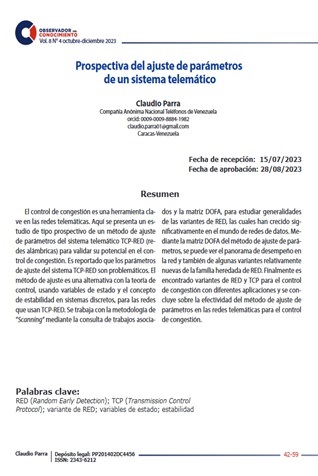Prospective adjustment of a telematics system
Keywords:
RED (Random Early Detection), TCP (Transmission Control Protocol), RED variant, state variables, stabilityAbstract
Congestion control is a key tool in telematic networks. Here it is present a prospective study of a parameter adjustment method of the TCP-RED telematics system (wired networks) to validate its potential in congestion control. It is reported that the TCP-RED system adjustment parameters are problematic. The adjustment method is an alternative to control theory, using state variables and the concept of stability in discrete systems, for networks which use TCP-RED. The “Scanning” methodology is used by consulting associated works and the FODA matrix, to studies generalities of the RED variants, which have grown significantly in the world of data networks. Using the FODA matrix of the parameter tuning method, one can see the performance landscape of the network and of some relatively new variants of the legacy RED family. Finally, variants of RED and TCP are found for congestion control with different applications and the effectiveness of the method of parameter adjustment in telematic networks for congestion control is concluded.
Downloads
References
Abu-Shareha, A. (2019). Enhanced Random Early Detection using responsive Congestion indicadors. IJACSA, 10(3). https://thesai.org/Publications/ViewPaper?Volume=10&Issue=3&Code=IJACSA&SerialNo=47
Ahmed, A. y Nasrelden, N. (2018). New congestion control algorithm to improve computer network performance. 2018 International Conference on Innovate Trend in Computer Engineering. Aswan, pp. 87-93. https://ieeexplore.ieee.org/document/8316605/
Baena, G. (2016). Prospectiva: sus métodos y técnicas. Instituto de Administración Pública del Estado de México, A.C. https://iapem.edomex.gob.mx/editorial/revistas/2016LPSMT.pdf
Betancourt, R. (2022). Viendo el futuro a través de la prospectiva tecnológica. Revista Observador del Conocimiento, 7 (3), pp. 144-163.
Danladi, S. y Ambursa, F. (2019). Dyred: an enhanced random early detection based on a new adaptive congestion control. ICECCO. Nigeria, pp. 1-5. https://www.semanticscholar.org/paper/DyRED%3A-An-Enhanced-Random-Early-Detection-Based-on-Danladi-Ambursa/cbc8967796e5c56b899cafb69a9e5df22ce9e594
Dorf, R. y Bishop, R. (2008). Modern Control Systems. Prentice Hall, USA.
Feng, W. et al. (2002). The blue active queue management algorithm. IEEE/ACM Transactions on networking. https://ieeexplore.ieee.org/abstract/document/1026008
Floyd, S. y Jacobson, V. (1993). Random Early Detection gateways for Congestion Avoidance. IEEE/ACM Transactions on Networking, 1 (4), pp. 397-413. https://www.icir.org/floyd/papers/early.twocolumn.pdf
Giménez, A. et al. (2022). New RED Type TCP-AQM algorithms based on Beta Distributions drop functions. Appl. Sci. MDPI. https://www.mdpi.com/2076-3417/12/21/11176
Ohsaki, H. y Murata, M. (2002). Steady State Analysis of the RED gateway: stability, Transient Behavior, and Parameter Setting. IEICE Trans. Commun., E85-B, (1), pp. 1-26. https://www.anarg.jp/achievements/annual_report/web2001/papers/oosaki01ieice-RED.pdf
Parra, C. (2010). Análisis del algoritmo red con la teoría de control moderna. Revista de la Facultad de Ingeniería, Universidad Central de Venezuela,25 (1).
Powell, F. G. y Workman, J. (1998). Digital Control of Dynamic Systems. Adison-Wesley Press.
Ryu, S. y Rump, C. (2003). Advances in internet congestion control. IEEE Communications. Third Quarter, 5 (1). https://dl.acm.org/doi/abs/10.1109/COMST.2003.5342228
Srikant, R. (2004). The Mathematics of Internet Congestion Control. Birkäuser.
Welzl, M. (2005). Network Congestion Control. Wiley.

Downloads
Published
How to Cite
Issue
Section
License

This work is licensed under a Creative Commons Attribution-NoDerivatives 4.0 International License.







